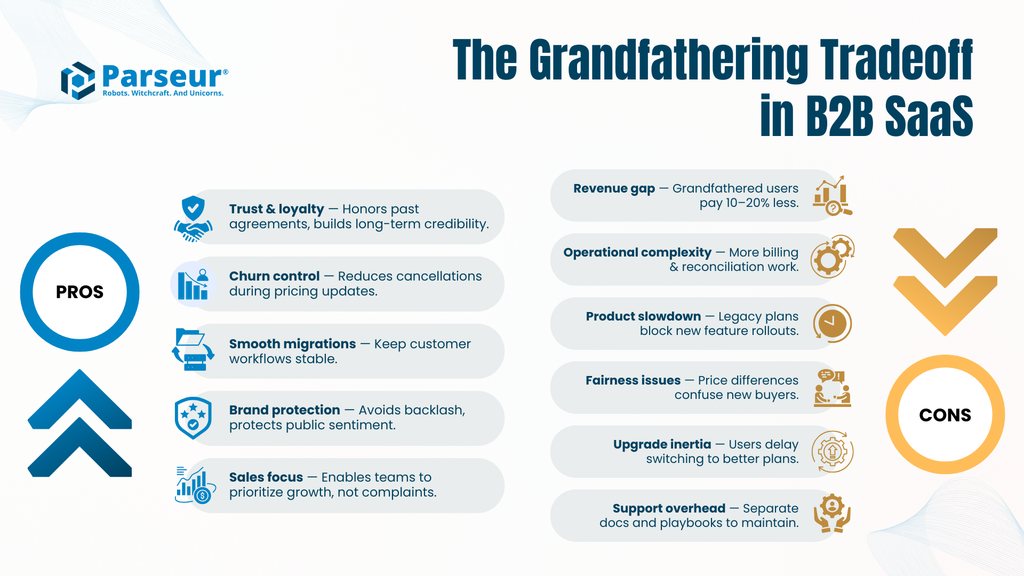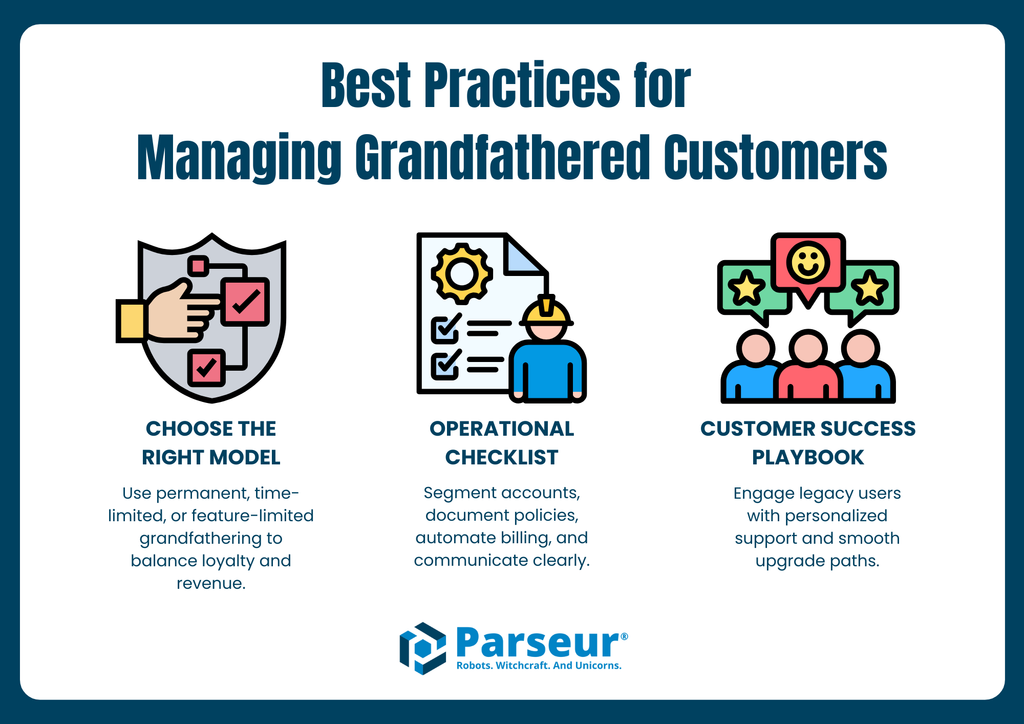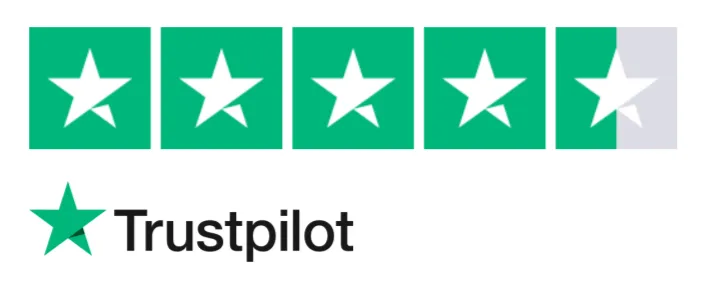What is grandfathering in B2B SaaS?
Grandfathering is the practice of allowing existing customers to remain on an older plan while new customers transition to updated, higher, pricing. It is a customer-first pricing decision many B2B SaaS companies use to keep long-term customers on older plans. This article explains what grandfathering means, the business pros and cons, best practices to protect revenue and relationships, how to estimate revenue impact, and exactly how Parseur approaches grandfathering for long-term clients.
Key Takeaways:
- Grandfathering helps SaaS companies maintain customer trust and minimize churn during pricing transitions.
- The main challenge is balancing loyalty with revenue growth through clear policies and measurable KPIs.
- At Parseur, we honor long-term customers with transparent grandfathering policies that protect both relationships and recurring revenue.
Grandfathering, also known as legacy or grandfathered pricing, is the practice of allowing existing customers to remain on an older plan or product version, while new customers transition to updated pricing or packages.
In B2B SaaS, this typically happens after a pricing change, feature restructuring, or product tier update. Instead of forcing every user to switch immediately, the company “grandfathers” its current customers to preserve stability and goodwill.
In 2025, SaaS pricing is seeing one of the steepest hikes in years, with average B2B software prices up by 11.4% compared to 2024, a rate nearly five times higher than the average market inflation among G7 countries. Half of all software vendors are planning further price increases. However, due to heightened sensitivity among legacy customers, many companies still choose to “grandfather” existing users to old pricing and limit steep hikes to new accounts.
According to Vitally, rising churn, now at an industry average of 3.5% per month, mainly split between customer-initiated and payment failure churn, has caused B2B SaaS companies to double down on retention strategies; practical approaches, such as transparent price transitions and legacy plan protection, consistently yield below-average churn rates and stabilize recurring revenue.
It’s a strategic tradeoff: you maintain trust with loyal users and minimize churn risk, but you also end up with a group of customers paying less (or getting more) than newer ones. Most companies use grandfathering to reward loyalty, reduce friction during transitions, and avoid negative sentiment that could harm long-term reputation.
OpenView’s SaaS Benchmark Report found that net dollar retention rates across B2B SaaS have hovered between 99% and 104% in recent years, a key metric strongly linked to how companies manage price increases and legacy customers.
When managed thoughtfully, grandfathering strengthens customer relationships and signals respect for early adopters. However, if left unchecked, it can hinder revenue growth, introduce complexity to product management, and create uneven support obligations between existing and new plans.
Why SaaS Teams Choose To Grandfather (Pros)

Grandfathering offers tangible benefits that go beyond customer goodwill. For B2B SaaS teams, it’s a strategic tool for managing change while protecting relationships and maintaining revenue stability.
- Customer trust & loyalty
Keeping existing customers on their original plans builds credibility. It demonstrates an honor of prior agreements and a value for long-term partnerships, an especially important signal in B2B, where trust and integration run deep.
- Churn reduction & retention
Sudden pricing or feature changes often create frustration or cancellations. Grandfathering minimizes that churn risk by giving customers time to adjust, explore the new value, and upgrade on their own terms.
- Lower friction for migrations
A major plan or feature change can disrupt workflows. By letting existing users remain on familiar setups, you prevent operational headaches and make migration planning smoother for both teams and customers.
- Brand & PR protection
Customers rarely complain about stability. Avoiding forced price hikes protects your brand reputation, reduces refund requests, and maintains a positive public sentiment during pricing transitions.
- Sales enablement
When customers aren’t upset about pricing changes, your sales and success teams can focus on what matters: driving adoption, upselling, and expansion, rather than managing backlash.
The Downsides And Hidden Costs Of Grandfathering (Cons)
Grandfathering can preserve trust, but it comes with real financial and operational trade-offs. These costs often surface months after a pricing change, impacting revenue, efficiency, and long-term scalability.
- Direct revenue opportunity cost
The most visible downside is financial. According to Saastr, grandfathered users often pay 10–20% less than new customers, creating a growing revenue gap as SaaS prices rise at an annual rate of 8–11%. This creates a measurable revenue gap that compounds as your customer base grows.
As Patrick McKenzie notes in his analysis of SaaS pricing strategy, underpricing and indefinitely maintaining legacy rates can quietly cap growth and distort long-term revenue potential.
- Complexity for billing & operations
Each legacy plan adds layers of billing logic, invoicing rules, and edge cases that finance and engineering must manage. Over time, this complexity drives up maintenance and reconciliation overhead.
- Product and roadmap friction
Supporting outdated plans can prevent you from fully deprecating old features or releasing clean, simplified versions of your product. This slows innovation and complicates QA cycles.
- Sales and fairness perception
Prospective customers may find it confusing or even unfair when they find that older users are paying less for similar value. This inconsistency can make pricing discussions harder for sales teams.
- Upgrade inertia
Customers who benefit from legacy pricing often delay or avoid upgrading, even when the new tiers offer better ROI. This stalls revenue growth and slows account expansion.
- Support and documentation overhead
Every grandfathered plan requires its own documentation, FAQs, and playbooks. Your customer success and support teams must manage two realities: legacy and current, which doubles the communication workload.
How To Estimate Revenue Loss From Grandfathering
Before deciding to maintain legacy pricing, SaaS teams should quantify the potential revenue impact. Estimating this loss helps weigh the cost of loyalty against the value of retention.
Practical Method
The simplest way to calculate the impact is to measure the difference between what grandfathered customers pay today and what they would pay under your new pricing model.
Formula:

If only a portion of customers remain grandfathered, multiply by the expected number of months they’ll stay on legacy pricing.
Worked Example
Let’s walk through a simple scenario:
- 200 grandfathered customers pay $50/month.
- The new comparable plan costs $75/month.
Step 1: Price difference per customer = $75 − $50 = $25
Step 2: Monthly revenue loss = $25 × 200 = $5,000
Step 3: Annualized revenue loss = $5,000 × 12 = $60,000
If only half the customers (100) remain grandfathered for one year, the annual impact = $25 × 100 × 12 = $30,000.
Important Notes
- This figure represents lost new revenue, not total loss; it doesn’t account for churn savings or lifetime value improvements from higher retention.
- For accurate forecasting, segment customers by ARR, usage, contract term, and upgrade likelihood to understand the actual financial trade-off.
Best Practices & Playbook for Managing Grandfathered Customers

Grandfathering is most effective when it’s deliberate, documented, and monitored. Below is a practical framework that product, finance, and customer success teams can use to manage legacy pricing without losing control of complexity or revenue.
Policy Design: Choose the Right Model
Permanent grandfather (rare)
At Parseur, we keep legacy terms indefinitely for a small, strategic cohort. For example, early adopters or flagship customers. Simple for users but carries a high long-term revenue cost.
Time-limited grandfather
Offer old pricing for a fixed period (e.g., one renewal cycle or 12–24 months). This balances customer loyalty with future pricing alignment.
Feature-limited grandfather
Maintain old pricing but gate new features for current plans. Customers can access new functionality via add-ons or upgrades, encouraging migration without sudden cost changes.
Contractual grandfathering
Honor legacy pricing terms only for the duration of existing contracts. When renewal comes, align the customer with the latest structure.
Operational Checklist (Step-by-Step)
Inventory & segment
Export all grandfathered accounts and record ARR, contract dates, product usage, and satisfaction scores (NPS/CSAT).
Quantify impact
Run the revenue loss formula from Section 4 for each cohort. Include retention or churn-lift assumptions to capture the full financial trade-off.
Document policy
Write and store an internal policy outlining who qualifies, what benefits apply, and any sunset dates or exceptions. Keep this accessible in billing and CS playbooks.
Billing system mapping
Use plan flags, feature toggles, or entitlements in your billing system to prevent accidental upgrades, downgrades, or incorrect renewals.
Communication plan
Inform customers proactively with clear reasoning, benefits, and timelines. Anchor messages in transparency and gratitude (“We value your partnership, and here’s how we’re handling the transition.”).
Upgrade path & incentives
Design upgrade offers that reduce friction with limited-time discounts, added features, or usage-based credits. Make moving to new plans a positive experience, not a forced change.
Monitor KPIs
Track migration progress: conversion rate from legacy → new plan, incremental ARR, churn, and support tickets. Review these metrics quarterly with cross-functional teams to ensure alignment and effectiveness.
Sunset roadmap
For time-limited grandfathering, publish a clear deprecation timeline to ensure a smooth transition. Send reminders at 6, 3, and 1 month intervals before the change to avoid surprises.
Legal & finance sign-off
In contractual grandfathering cases, confirm details with the legal team and ensure that renewal clauses reflect the new pricing terms.
Customer Success Playbook Suggestions
- Treat grandfathered customers as high-touch accounts, assign a CSM to discuss roadmap benefits and upgrade timing.
- Host migration workshops or webinars that demonstrate how new plans lower the total cost of ownership or enhance automation.
- Use usage data and ROI examples to personalize upgrade outreach (e.g., “With Feature X, you could save 10 hours a month, here’s the math.”)
Mitigation Strategies That Preserve Trust And Protect Revenue
Grandfathering doesn’t have to mean locking in lost revenue. With thoughtful design, you can maintain customer goodwill while gradually rebalancing your pricing model. Below are practical ways SaaS teams can honor legacy commitments while still protecting their margins.
- Add-On Pricing
Keep the base grandfathered rate intact but introduce add-ons for new features, integrations, or advanced automation. This allows legacy users to access innovation without forcing them to switch to a new plan immediately.
- Feature Gating
Maintain the original feature set for legacy plans and gate new or premium features under updated pricing tiers. This helps clarify value differences and naturally encourages users to upgrade.
- Contract Renewal Alignment
Use renewal points as the cleanest time to realign pricing. Include clear opt-in or opt-out language so customers feel in control, and tie the change to measurable improvements in the product.
- Usage-Based Surcharges
When feasible, apply metered surcharges for overages or heavy usage rather than broad price increases. This matches revenue with usage growth and avoids penalizing light users.
- Migration Credits & Temporary Discounts
Offer limited-time upgrade incentives such as account credits, transition discounts, or bundled perks. These reduce upgrade friction and reward early adopters for their loyalty.
- Grandfathered Cohort Monetization
Turn loyal, grandfathered customers into premium advocates, create exclusive partner programs, beta access, or paid support tiers. This approach preserves trust while generating incremental value from your legacy base.
Data & KPIs To Monitor
To make informed decisions about grandfathering, SaaS teams need clear visibility into their financial and operational impact. Tracking the proper metrics helps determine whether your grandfathering strategy protects loyalty without eroding long-term revenue.
Here are the key metrics to monitor:
- Number of Grandfathered Accounts (by Cohort)
Track the number of customers remaining on legacy plans, segmented by signup date, product version, or region. This shows the true scale and duration of grandfathered exposure.
- Monthly Revenue Gap
Calculate the total monthly price difference between legacy and current plans, the direct revenue opportunity cost. This metric links grandfathering decisions to the measurable impact on ARR.
- Upgrade Conversion Rate
Measure how many grandfathered customers migrate to new plans after campaigns or feature releases. This highlights the effectiveness of upgrade strategies and messaging.
- Churn Rate (Grandfathered vs. Overall)
Compare churn between legacy and active plan cohorts. A higher churn rate in legacy accounts may indicate feature fatigue or a perception of poor value; conversely, a lower churn rate suggests strong loyalty.
- Support & Feature Request Volume
Monitor ticket trends and product feedback from grandfathered users. High request volume may signal frustration with feature gating or outdated plan limitations.
- Time to Upgrade After Campaigns
Track the average duration from targeted communication (email, webinar, discount) to successful plan upgrade. This helps improve timing and incentive design.
- Customer Lifetime Value (CLV)
Compare CLV for legacy vs. new plan customers. This reveals whether loyalty-driven grandfathering yields sustainable long-term value or masks hidden revenue leaks.
Legal, Accounting, And Product Considerations
Grandfathering isn’t just a pricing or customer success decision; it has legal, accounting, and product implications that can create downstream risk if overlooked. Address these early to ensure compliance, accuracy, and scalability.
Contracts
Always honor existing contractual terms. For any adjustments, present clear amendments at renewal and avoid retroactive changes. Transparent communication fosters trust and reduces legal liability.
Accounting
Segment legacy revenue separately for clean forecasting and reporting. Treat grandfathered accounts as their own cohort when calculating ARR, MRR, and revenue recognition, ensuring accurate comparisons across pricing versions.
Product
Use feature flags and version control to isolate older plan logic and minimize technical debt. This approach enables your product and engineering teams to sunset legacy UX or feature sets gracefully, without disrupting functionality for users who are grandfathered.
How Parseur Treats Grandfathered Customers (Our Approach & Values)
At Parseur, we value long-term customers, and that principle extends to our pricing philosophy. We grandfather all long-term clients, meaning when we update pricing or repackage features, existing customers keep their original rate while still enjoying the improvements and benefits of the new plan. In other words, they get the new experience at their legacy price, a tangible thank-you for their trust and loyalty.
What That Looks Like in Practice
- Full benefit, old price: Grandfathered customers automatically receive new features, performance updates, and product improvements without being moved to the new pricing tier.
- Discount vouchers on upgrades: During major pricing updates, we issue discount vouchers or credits to loyal customers, our way of honoring their commitment and bridging any perceived gap between old and new pricing.
- Transparent communication: We proactively share upcoming changes, explain what’s new, and clarify how legacy terms apply, always with gratitude and openness.
- Operational discipline: Grandfathered accounts are clearly flagged in our billing and CRM systems to prevent errors and ensure a seamless experience.
- Low-friction upgrade path: Customers who wish to switch to a different plan can do so easily, often with the application of vouchers or personalized migration support.
- Dedicated customer success: Our CSMs maintain close contact with grandfathered customers, offering tailored check-ins, ROI discussions, and optional upgrade pathways, without forcing changes.
Why We Do It
Parseur’s business is built on long-term trust. Our customers integrate Parseur deeply into mission-critical workflows, and honoring their investment means respecting both their time and budget. While grandfathering may result in a short-term revenue trade-off, it pays dividends in terms of retention, advocacy, and lifetime value. For us, loyalty isn’t a policy; it’s a partnership.
I searched google for "AI tool to extract data from over 5,000 PDF of electrical bills and put in to an excel file". I was given 3 options. I viewed all of them. Parseur was priced right and fit my needs perfectly. - Joe Z. Project Manager
We have customers that are still on a long-discontinued 1,000 credits, $9/month plan (that same plan now costs $129/month). We keep them on because they were here when each customer was like an oasis in the desert for Parseur, keeping the lights on and the food on the table. They deserve our gratitude. - Sylvain Josserand, Parseur’s co-founder
Balancing Loyalty And Growth Through Smart Grandfathering
Grandfathering in B2B SaaS is ultimately about balance by honoring loyal customers while ensuring sustainable growth. The right strategy depends on your values, customer mix, and operational readiness. At Parseur, we prioritize transparency, fairness, and long-term relationships, utilizing structured policies to manage legacy plans responsibly. By applying the formulas, playbooks, and best practices in this guide, you can design a pricing transition that protects both trust and revenue.
Frequently Asked Questions
Transitioning pricing models can raise questions, especially when legacy customers are involved. This FAQ addresses the most common concerns about grandfathered plans, pricing updates, and how Parseur approaches them with transparency and fairness.
-
Will my existing plan or features be changed?
-
No. If you’re a grandfathered Parseur customer, your existing plan and features remain fully active. You’ll continue receiving all product improvements tied to your plan at no additional cost.
-
How long will my grandfathered pricing last?
-
Parseur’s policy is to honor your original rate indefinitely unless you choose to migrate to a new plan voluntarily. If future structural changes are needed, you’ll receive clear advance notice.
-
Can I switch to a new plan later?
-
Absolutely. You can move to a new plan at any time. Parseur offers migration assistance and may apply discount vouchers or credits to make the transition smooth.
-
Why do some customers have different pricing?
-
Pricing differences reflect legacy terms and new feature packages introduced over time. Grandfathered users keep the value they originally signed up for, while new customers benefit from updated bundles and support levels.
-
How will I be notified about future pricing or plan updates?
-
Parseur proactively communicates all changes via email and in-app messages, typically 30 to 90 days in advance, emphasizing transparency and partnership.
Last updated on




